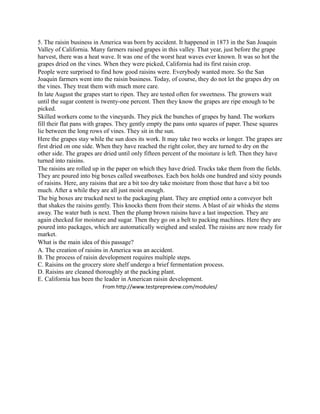
How America's raisin industry began by accident in 1873
- 1. 5. The raisin business in America was born by accident. It happened in 1873 in the San Joaquin Valley of California. Many farmers raised grapes in this valley. That year, just before the grape harvest, there was a heat wave. It was one of the worst heat waves ever known. It was so hot the grapes dried on the vines. When they were picked, California had its first raisin crop. People were surprised to find how good raisins were. Everybody wanted more. So the San Joaquin farmers went into the raisin business. Today, of course, they do not let the grapes dry on the vines. They treat them with much more care. In late August the grapes start to ripen. They are tested often for sweetness. The growers wait until the sugar content is twenty-one percent. Then they know the grapes are ripe enough to be picked. Skilled workers come to the vineyards. They pick the bunches of grapes by hand. The workers fill their flat pans with grapes. They gently empty the pans onto squares of paper. These squares lie between the long rows of vines. They sit in the sun. Here the grapes stay while the sun does its work. It may take two weeks or longer. The grapes are first dried on one side. When they have reached the right color, they are turned to dry on the other side. The grapes are dried until only fifteen percent of the moisture is left. Then they have turned into raisins. The raisins are rolled up in the paper on which they have dried. Trucks take them from the fields. They are poured into big boxes called sweatboxes. Each box holds one hundred and sixty pounds of raisins. Here, any raisins that are a bit too dry take moisture from those that have a bit too much. After a while they are all just moist enough. The big boxes are trucked next to the packaging plant. They are emptied onto a conveyor belt that shakes the raisins gently. This knocks them from their stems. A blast of air whisks the stems away. The water bath is next. Then the plump brown raisins have a last inspection. They are again checked for moisture and sugar. Then they go on a belt to packing machines. Here they are poured into packages, which are automatically weighed and sealed. The raisins are now ready for market. What is the main idea of this passage? A. The creation of raisins in America was an accident. B. The process of raisin development requires multiple steps. C. Raisins on the grocery store shelf undergo a brief fermentation process. D. Raisins are cleaned thoroughly at the packing plant. E. California has been the leader in American raisin development. From http://www.testprepreview.com/modules/
